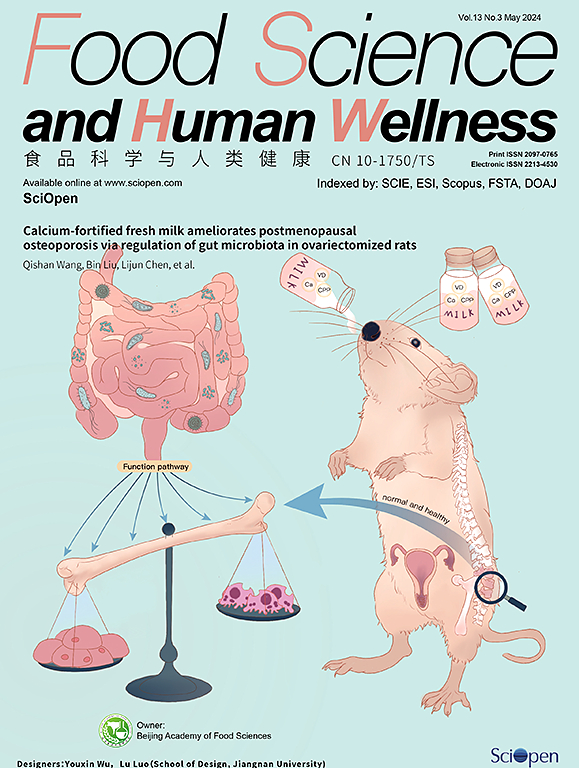苏州异冬青通过表皮生长因子受体/TLR4途径抗COVID-19的潜在机制
IF 7.4
1区 农林科学
Q1 FOOD SCIENCE & TECHNOLOGY
引用次数: 0
摘要
2019冠状病毒病(COVID-19)给科学研究带来了新的挑战。苏州Isodon suzhouensis具有良好的抗炎和抗氧化应激作用,被认为是治疗COVID-19的潜在药物。采用分子对接和网络药理学的方法,探讨苏舟依菌治疗新冠肺炎的可能性及其潜在的作用机制。采用网络药理学和分子对接方法筛选药物靶点,采用脂多糖(LPS)诱导的RAW264.7和NR8383细胞炎症模型进行实验验证。总共筛选出了209个与苏州市依蚊18种化学成分的可能连锁位点,以及1194个与COVID-19相关的靶点。其中,从苏州依蚊与COVID-19的交叉点获得164个共同靶点。基因本体(GO)和京都基因与基因组百科全书(KEGG)分别富集了582个功能靶点和87个靶蛋白通路。分子对接研究结果表明,芦丁、牡荆素、异槲皮素和槲皮素与3个凝乳胰蛋白酶样蛋白酶(3CLpro)和血管紧张素转换酶2 (ACE2)具有显著的结合能力。体外研究表明,苏竹提取物(ISE)可能通过抑制LPS诱导RAW264.7细胞中表皮生长因子受体(EGFR)的激活,抑制PI3K/Akt通路的激活及下游促炎因子的表达水平。此外,ISE能够抑制LPS作用下NR8383细胞中TLR4/NF-κB信号通路的激活。综上所述,网络药理学和体外研究表明,苏州树活性成分在多靶点、多途径维度上具有较强的抗COVID-19治疗潜力,是一种有前景的抗COVID-19候选药物。本文章由计算机程序翻译,如有差异,请以英文原文为准。

The potential mechanism of Isodon suzhouensis against COVID-19 via EGFR/TLR4 pathways
Corona Virus Disease 2019 (COVID-19) has brought the new challenges to scientific research. Isodon suzhouensis has good anti-inflammatory and antioxidant stress effects, which is considered as a potential treatment for COVID-19. The possibility for the treatment of COVID-19 with I. suzhouensis and its potential mechanism of action were explored by employing molecular docking and network pharmacology. Network pharmacology and molecular docking were used to screen drug targets, and lipopolysaccharide (LPS) induced RAW264.7 and NR8383 cells inflammation model was used for experimental verification. Collectively a total of 209 possible linkages against 18 chemical components from I. suzhouensis and 1 194 COVID-19 related targets were selected. Among these, 164 common targets were obtained from the intersection of I. suzhouensis and COVID-19. Gene Ontology (GO) and Kyoto Encyclopedia of Genes and Genomes (KEGG) enriched 582 function targets and 87 target proteins pathways, respectively. The results from molecular docking studies revealed that rutin, vitexin, isoquercitrin and quercetin had significant binding ability with 3 chymotrypsin like protease (3CLpro) and angiotensin converting enzyme 2 (ACE2). In vitro studies showed that I. suzhouensis extract (ISE) may inhibit the activation of PI3K/Akt pathway and the expression level of downstream pro-inflammatory factors by inhibiting the activation of epidermal growth factor receptor (EGFR) in RAW264.7 cells induced by LPS. In addition, ISE was able to inhibit the activation of TLR4/NF-κB signaling pathway in NR8383 cells exposed to LPS. Overall, the network pharmacology and in vitro studies conclude that active components from I. suzhouensis have strong therapeutic potential against COVID-19 through multi-target, multi-pathway dimensions and can be a promising candidate against COVID-19.
求助全文
通过发布文献求助,成功后即可免费获取论文全文。
去求助
来源期刊

Food Science and Human Wellness
Agricultural and Biological Sciences-Food Science
CiteScore
8.30
自引率
5.70%
发文量
80
审稿时长
28 days
期刊介绍:
Food Science and Human Wellness is an international peer-reviewed journal that provides a forum for the dissemination of the latest scientific results in food science, nutriology, immunology and cross-field research. Articles must present information that is novel, has high impact and interest, and is of high scientific quality. By their effort, it has been developed to promote the public awareness on diet, advocate healthy diet, reduce the harm caused by unreasonable dietary habit, and directs healthy food development for food industrial producers.
 求助内容:
求助内容: 应助结果提醒方式:
应助结果提醒方式:


